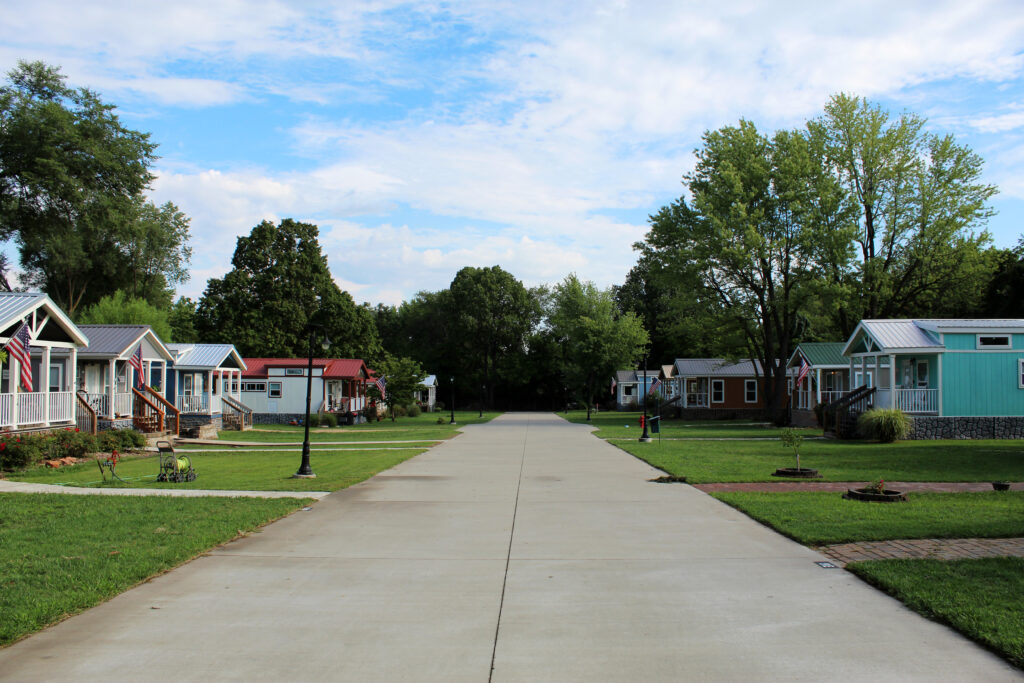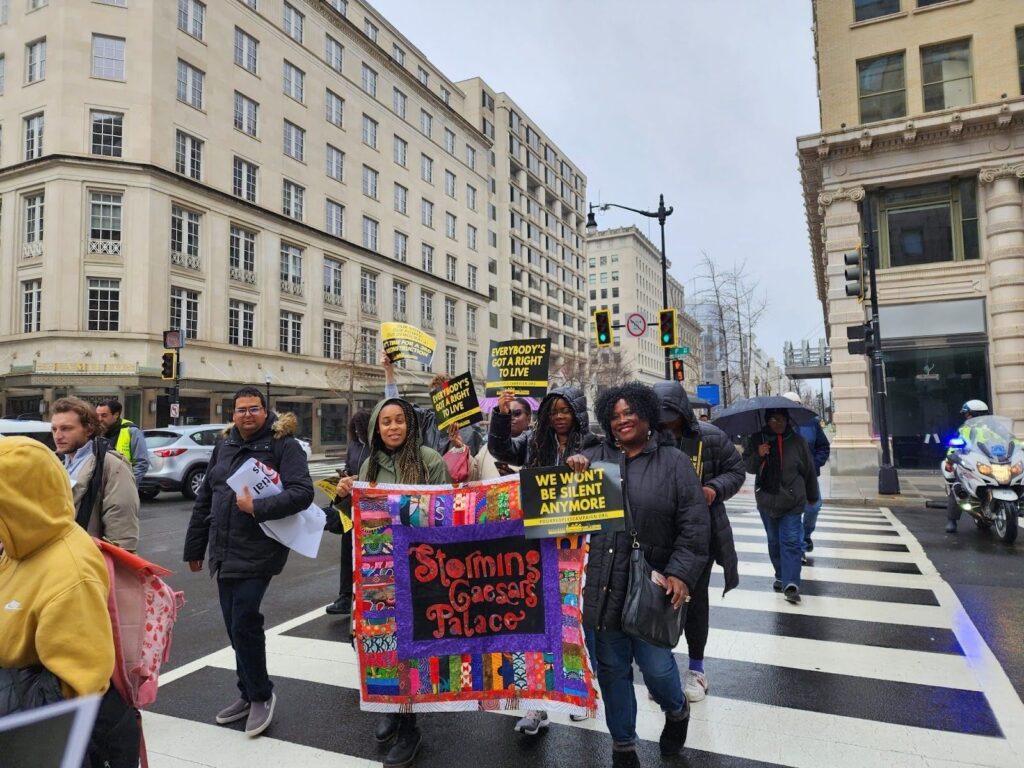On a late summer morning in Springfield, Missouri, Lymon Sanderson stood in front of his 400-square-foot house and drank in the vibrant oranges, blues and greens of his neighbors’ homes.
Sanderson lives in a tiny home community known as Eden Village. It was built by a religiously affiliated nonprofit called The Gathering Tree to provide people without homes a place to live.
Tiny homes have become popular in recent years with hundreds of communities popping up all across the country. Some municipalities have embraced this trend and found that tiny home communities could provide a way to build more dense and affordable housing to the people who need it most.
A city like D.C. would face a litany of challenges in trying to build a tiny home community. Not only would it have to contend with restrictive zoning laws preventing this kind of development, it would also have to find the space. There would be other inevitable challenges, such as where to find the funding and how to deal with residents who do not want to see these kinds of projects in their neighborhoods.
Rethinking the way communities tackle homelessness
David and Linda Brown started Eden Village in 2016. All of the homes are considered to be “permanent supportive housing,” meaning residents may live in their homes for the remainder of their lives as long as they follow the rules set forth by the community. Residents who have experienced chronic homelessness and have a mental or physical disability pay $325 a month in rent, which covers utilities and access to support services.
“Since our first resident was put in in 2018, we are seeing life change,” Linda Brown said. “It’s a solution to a problem, and it really works.”

D.C. is no stranger to permanent supportive housing (PSH). It funded a record new 2,400 PSH vouchers for the 2022 fiscal year to help move people without homes into housing, but at close to the end of the fiscal year less than 600 people have been able to move into housing due to a variety of factors, including discrimination from landlords and the high cost of local rent.
The biggest barrier D.C. would face in trying to establish a tiny home community similar to Eden Village is finding the land to build it.
“Where is it going to go?” said Christina Peay, president of philanthropy and communications at Housing Up, a nonprofit in the District that helps connect families to affordable housing and support services. “That’s a hurdle that we face even just building traditional affordable housing with zoning.”
One potential site cities can explore is run down mobile home parks. These locations already have connections to water, sewage and electricity, according to Cathy Ritter, who is in the early stages of creating an extension of the Missouri-based Eden Village tiny home community outside of Richmond, Virginia. Ritter said mobile home parks are also usually zoned appropriately for a tiny home village.
The closest mobile home parks to the District are in Maryland and Virginia, making the possibility of constructing a tiny home community in D.C. more difficult.
If a mobile home park is not available, developers must look for vacant lots that can be used for housing with support services, according to local zoning laws. If a developer needs to rezone, Brown said it could be a “nightmare.”
Transitioning from unsheltered living to a home
As District authorities evict people from encampments, Robert Warren, Street Sense Media vendor and co-director of the People For Fairness Coalition, said tiny homes could be a better way to approach connecting people to housing, if the city could find space for them.
“I think it still could be a viable part of how you address people’s housing needs in the District of Columbia, especially with the encampments and some of the protocols that they’ve been putting in place,” Warren said.
The District conducts between 70 and 100 encampment engagements every year, discarding waste from sites and closing some of them permanently, displacing residents.
For Warren, building a tiny home community in itself would be insufficient in addressing the needs of helping people move into stable housing. He said he believes it is crucial for housing providers to think about the inclusion of supportive services, including case management and peer support. These services, he said, can help ease the transition people make from living in shelters or on the street to living in a tiny home.
Because of spatial issues, a tiny home community would be a more viable option in Maryland or Virginia, but Warren doesn’t want to see people having to uproot from their communities in order to access one.
Klaus Philipsen, an architect and urban designer based in Baltimore and a former Regional and Urban Design Committee member in D.C., agreed that tiny home villages are not best suited for the District.
“From an urban design perspective, a village of tiny homes is not necessarily something that fits right into the urban fabric of a city like D.C., where there are very few vacant lots because the demand for development is so high that every last corner gets developed,” Philipsen said.
Philipsen explained the spectrum of tiny home projects ranges from tent communities to full homes that are a smaller size, like Eden Village. He said resident autonomy is important.
“A lot of the acceptance is also to deal with the services, the wraparound services, that are provided and the oversight, but it would be kind of nice if there was also some kind of self-policing going on in these villages and some autonomy in their governance,” Philipsen said.
Accessory dwelling units are a potential answer
Greg Cantori, the former president and CEO of Maryland Nonprofits, is a tiny home enthusiast, working to make tiny homes a more widespread solution in Maryland. He lives in a 39-foot-long boat “in the best spot in Annapolis” with his wife and two dogs.
Cantori sees many issues with the tiny home village model.
“My biggest concern is that it segregates — it brings back the whole problem of segregation,” Cantori said. “I always think that you have sort of an unhealthy neighborhood when you can point to a community and say, ‘That’s where the poor live. That’s where the rich live.’”

Cantori said he believes the best and most sustainable option is for homeowners with extra land to allow tiny homes on their property for people to rent or own. This is a new solution facing issues in other areas because of local laws.
In D.C., this type of housing is called an accessory apartment.
The District has explored various strategies in recent years to address the affordable housing crisis, like using inclusionary zoning to spur the development of mixed-income housing, but accessory apartments could offer a new way ahead.
In the past year, Maine passed a law designating tiny homes as single family dwellings, effectively eliminating barriers for tiny homes as solutions to homelessness. Cantori said he hopes to see this type of legislation passed in more states.
According to zoning in D.C., accessory apartments are only permitted in residential zones or R zones, limiting where they can be located in the city. In order to establish an accessory apartment on their property, the owner must get approval from the Department of Consumer and Regulatory Affairs by obtaining a special license and passing an inspection.
Even though there are challenges to this solution, Cantori is dedicated to making it a more accessible option.
“I’ve even had friends mention, ‘Oh, I haven’t been in that bedroom in months.’ And I’m thinking, ‘Why do you have an extra bedroom they’re not using? What kind of waste of space is that?’” Cantori said. “There’s no shortage of housing — there’s a shortage of the will to allow the use of that housing. That’s the problem.”
He explained that the biggest pushback to affordable housing projects comes from Not In My Backyard people, or NIMBYs. For accessory dwelling units to be a viable option, Cantori said that Yes In My Back Yard people, or YIMBYs, need to organize and welcome tiny homes onto their properties.
“In the meantime, people — the wealthy white homeowners — are hanging onto their little fiefdoms. They’re bringing up the drawbridges and putting out the moats and preventing anybody from moving in the neighborhoods,” Cantori said. “We’re finding ways to infiltrate them behind the lines and create these housing types without the NIMBYs realizing that’s happening to them until it’s too late.”
Backyard Homes Building Company builds detached accessory dwelling unit homes for clients in D.C. and Virginia. Tiny homes could be a solution in this area by modifying a model like this into affordable housing for people experiencing homelessness. An organization doing that is The Block Project in Seattle.
Cantori stressed that accessory dwelling unit legislation should unite all political parties.
“What I love about this is it means the arch liberals — the ones who say, ‘Hey, she has every right to live there’ — and the arch conservatives — which say, ‘Hey, you have every right to do what you want with the property without the government interfering’ — are on the same side of this issue,” Cantori said.
The way forward
Accessory dwelling units could be the way to keep people in D.C. and provide them with a tiny home.
On June 30, the D.C. Department of Housing and Community Development (DHCD) released a document requesting applications for the Residential Accessory Apartments Program (RAAP). This program was set to provide grant money by Sept. 30 to “qualified for-profit or non-profit/tax-exempt entities, either as a single entity or a partnership” to start a program to support at least 15 homeowners who seek to create accessory apartments on their existing properties within 18 months of receiving the funds.
Support will be based on homeowners’ income level, according to the document. Homeowners who have an MFI of 121% and above will be subject to an affordability covenant for their accessory apartments, meaning that the tenants must have an MFI of 60% or below.
The program is an effort by the District to lessen the financial burden on homeowners and developers to make their accessory apartments comply with the city’s requirements.
The District defines a residential accessory apartment as a secondary residence that “has kitchen and bath facilities separate from the principal dwelling and may have a separate entrance.”
When asked whether its chosen grant recipient received funds by the Sept. 30 deadline outlined in its document, DHCD provided the following statement.
“Funds, of which there are over $2.85 million budgeted, will be directly disbursed to the District’s partner as projects are undertaken,” the agency said. “DHCD will kick-off the program later this fall.”
Through this program, the number of accessory apartments in the District will grow at least by 15. While the zoning and requirements can be complicated, the District already has access to this solution, which is more than many other cities.
“When I go through big suburban neighborhoods now, all I can think of is, ‘Oh my God, oh my God, that would be so great to turn into an accessory dwelling unit,’” Cantori said. “‘You could slip one in there and no one even notice.’ See, you start thinking this way, and I’ve been thinking this way for years now, and I can’t get it out of my head. There’s so much wasted space.”
The article has been updated following a response from DHCD after the time of publication providing more information about the timeline and scope of the program. The original publication incorrectly stated that the RAAP would provide money directly to homeowners. The article has also been updated to correct a reference to YIMBYs.








